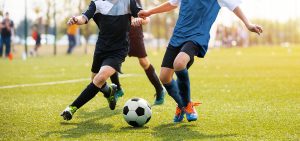
While youth sports provide many benefits including healthy weight, teamwork, discipline, and sportsmanship, they also increase the risk of injury. As parents, you can help young athletes have a positive experience by knowing the cause of kid sports injuries and learn how to prevent them.
Preventing Kids Sports Injuries
There are a few simple guidelines that can help protect your kids as they play sports.
- Talk to Your Child. Explain to your child how to play safely. Encourage them to be open and honest about any pain or discomfort they are feeling.
- Physical Exam. A physical can determine whether or not your child is able to safely meet the sport’s demands.
- Injury Prevention Commitment. Enroll your child in sports groups and organizations that have a commitment to injury prevention, train their coaches in first aid, and use proper equipment.
- Use Proper Equipment. Equipment and gear that are sized and fit well is the first line of defense. Look for protective equipment that’s approved by the organizations that govern each sport. These include the Consumer Product Safety Commission (CPSC) and the National Operating Committee on Standards for Athletic Equipment (NOCSAE).
- Warm-Ups & Cool-Downs. Teaching your child the importance of warm-ups and cool-downs will help reduce their risk of muscle strains and pulls.
- Water Breaks. Help your child get into the habit of water breaks every 20 minutes to prevent dehydration and/or heat exhaustion.
Common Types of Kids Sports Injuries
Acute injuries happen suddenly due to some form of trauma. For young children, this could mean minor bruises, sprains, and strains. More severe injuries like broken bones and torn ligaments are more likely for teenagers due to their weight and size.
- What to do: The rule of thumb is, “better safe than sorry.” If your child isn’t able to play or move normally, provide first aid immediately then see a doctor. If it’s more serious, take your child to the emergency room.
Overuse injuries occur from repetitive actions that put too much strain on bones and muscles. In young athletes, this can affect bone growth and create a lifelong injury that is difficult to treat.
Some of the most common types of overuse injuries are anterior knee pain, little league elbow (pain from repetitive throwing), swimmer’s shoulder (inflammation in the shoulder), shin splints (pain from repeated running), and spondylosis (pain in the lower back).
- What to do: If your child complains of pain or is noticeably injured, limit their activity until they can see a doctor. Their doctor can advise when it’s safe to return and diagnose and treat the injury. Immediate attention to overuse kid sports injuries will prevent lifelong problems.
Reinjuries happen when an athlete returns to the sport before the previous injury has completely healed. Returning before the injury has completely healed will put unnecessary strain on the injured site and force the body to overcompensate for the weakness. In turn, this will create a greater risk of injuring another body part.
- What to do: If a reinjury occurs, take your child to the doctor or the emergency room depending on the severity.
Treating Kids Sports Injuries
Even though you’ve done the best you can to prepare your child and prevent kids’ sports injuries, injuries can still happen. When they do it’s best to stop your child from continuing the activity. Don’t let them play through the pain and take them to the doctor for any obvious fracture, dislocation, prolonged swelling or chronic or severe pain.
Children suffering from a sprain or strain can try the RICE method.
- Rest to reduce or stop using the injured area for at least 48 hours.
- Ice the injured area for 20 minutes at a time 4-8 times a day.
- Compress to reduce swelling using elastic wraps, air casts, or splints for ankles, knees, or wrists.
- Elevate the injured area above the heart level to decrease swelling.
If you have any questions or suspect your child needs to be seen for a sports injury, you can book an appointment by calling our Raleigh, NC office at (919) 896-7076. HealthPark Pediatrics is committed to providing our patients with a medical home from birth to age 21, and all the stages of adolescence in between.









